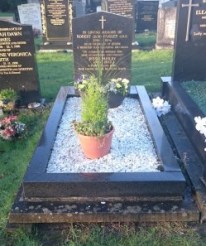Spring is a time when many tasks that have been left undone during the dark drab months of winter are completed. One of those can be tending to your loved one’s memorial; this may mean getting a new one altogether, cleaning the headstone and urn, leaving fresh flowers and clipping the grass around the edges.
Cemeteries are nice, colourful and fresh in the spring, with flowers blooming to brighten up weather beaten gravestones. The grass is freshly cut and days are longer and brighter, everything just looks so much tidier and neater. This is exactly what the Victorian landscapers had in mind when they designed the cemeteries where our loved ones are remembered today. In today’s less God fearing, it has also created an ambiance where cemeteries can be places where the lives of the deceased who rest there can be celebrated rather than mourned.
If you’re loved one’s grave remains without a heads tone, spring is the perfect time to have a new one installed as the ground is much more settled and firmer than in the winter. If the memorial is being fixed to a concrete base, then it is always advisable to install this during seasons when frost and heavy rain are less likely. The conditions in spring are also much more suitable for refurbishment of existing headstones, whether it be removing them to inscribe new lettering, or fixing a new ground anchor.
tone, spring is the perfect time to have a new one installed as the ground is much more settled and firmer than in the winter. If the memorial is being fixed to a concrete base, then it is always advisable to install this during seasons when frost and heavy rain are less likely. The conditions in spring are also much more suitable for refurbishment of existing headstones, whether it be removing them to inscribe new lettering, or fixing a new ground anchor.
Sarsfield Memorials provide a range of options for new headstones and refurbishment of existing ones. If you require a new standard headstone then we can usually have these installed within six weeks of you placing an order, so late February/early March is an ideal time to consider having one that will be ready in April. If all you need is for an existing gravestone to be cleaned up, this can usually be done sooner. We also provide grave tending services if you are unable to get to the cemetery yourself due to time, distance or health constraints. Please contact us and we will be happy to discuss your requirements and provide a free no obligation quote.


 ary achievements.’
ary achievements.’ stance. They can be made from a variety of materials, including wood, cardboard, ceramics and glass.
stance. They can be made from a variety of materials, including wood, cardboard, ceramics and glass.
 n home Pope John Paul II stayed when he visited the city in 1982, was still in office when he died of lung cancer. He was in Liverpool at a time when the city was faced with the Toxteth Riots and two great tragedies; Heysel and Hillsborough. The 1980s were also a period of severe economic downturn and Worlock worked with his Anglican equivalent, David Sheppard, to deal with the challenges. They co-wrote two books, Better Together and With Hope in Our Hearts, and were jokingly referred to as fish and Chips as they were always together and never out of the papers.
n home Pope John Paul II stayed when he visited the city in 1982, was still in office when he died of lung cancer. He was in Liverpool at a time when the city was faced with the Toxteth Riots and two great tragedies; Heysel and Hillsborough. The 1980s were also a period of severe economic downturn and Worlock worked with his Anglican equivalent, David Sheppard, to deal with the challenges. They co-wrote two books, Better Together and With Hope in Our Hearts, and were jokingly referred to as fish and Chips as they were always together and never out of the papers. en Liverpool became an ecclesiastical province. He died in office in 1921 at the age of sixty three. The other is that of Richard Downey, who oversaw the building of the crypt and had envisaged that the ultimate construction would have a great figure of Christ on it that would be seen for many a mile out at sea. He died whilst still in office in 1953, having served for twenty-four years.
en Liverpool became an ecclesiastical province. He died in office in 1921 at the age of sixty three. The other is that of Richard Downey, who oversaw the building of the crypt and had envisaged that the ultimate construction would have a great figure of Christ on it that would be seen for many a mile out at sea. He died whilst still in office in 1953, having served for twenty-four years.